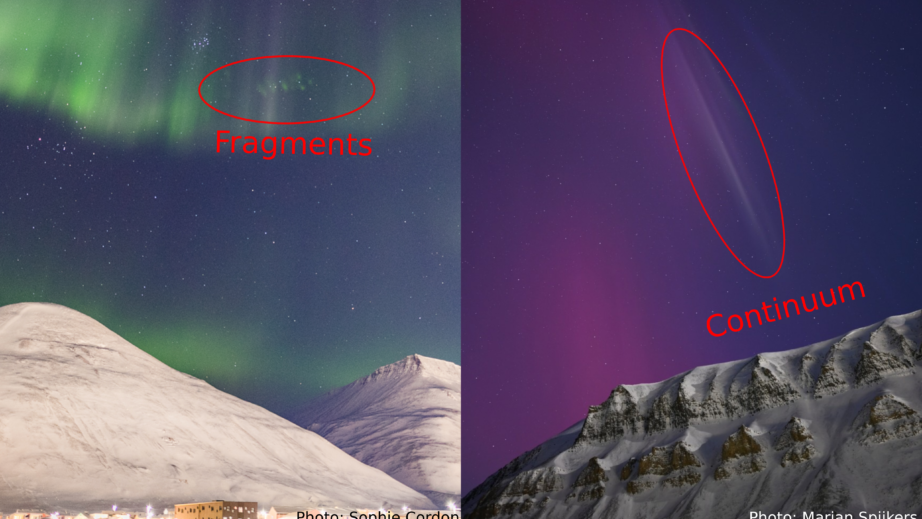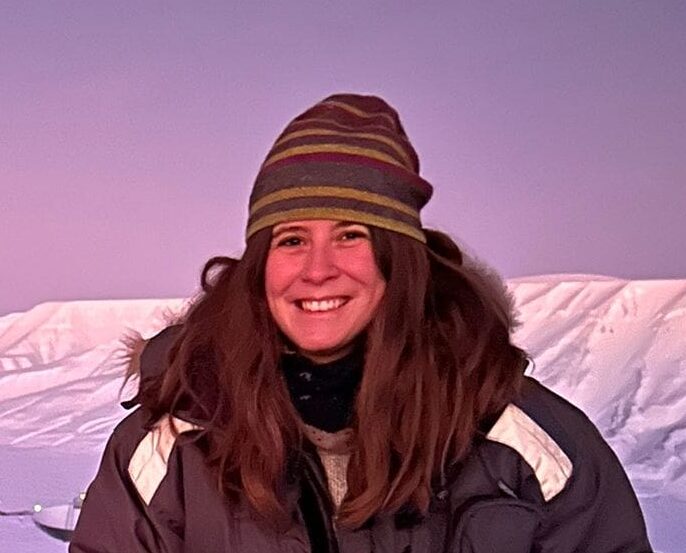SolarMaX: Astronauts Team Up with UNIS Space Physicists and Citizen Scientists
Fram2 will be the first human space mission to travel around the Earth’s polar regions. Named after the historical ship Fram, which went on groundbreaking expeditions to the Arctic and Antarctica, this mission will pioneer to be the first ever human space mission in polar orbit. Onboard Fram2 are four commercial astronauts, Chun Wang of Malta, Jannicke Mikkelsen of Norway, Rabea Rogge of Germany and Eric Philips of Australia.

Citizen scientists images of aurora-like phenomena over Svalbard (left) fragments by Sophie Cordon (right) continuum by Marjan Spijkers.
Astronaut and filmmaker Jannicke Mikkelsen will bring state of the art photographic equipment with her on the spaceflight. Dr Katie Herlingshaw (UNIS) researches light emissions that look like aurora but the causes of which are not yet understood. Both women live on Svalbard and they hatched up a plan for Fram2 and citizen scientists on the ground to gather data to learn more about strange aurora-like phenomena and to what extent they can affect satellite communication, navigation and drag. This resulting project is called SolarMaX!
What do we want to know about the Aurora Imposters?

The photos at the top of the article show two different light emissions that look like aurora. However, aurora is caused by particles flowing into the atmosphere from the Earth’s near-space region and these emissions do not come from that. The first photo shows fragmented aurora-like emissions (fragments) which are unusual since they form perpendicular to the magnetic field direction, often in a chain, unlike normal aurora. The second photo shows continuous emissions (continuum), which are special since normal aurora appears in very specific colours, but continuous emissions are made up of all colours, which combine to appear off-white.
Southern Relatives

Fragments and continuum bear many similarities to features that occur at much lower latitudes, on the equatorward side of the auroral oval. Super Thermal Emission Velocity Enhancement (STEVE) is also made up of all the colours, while streaks form in the perpendicular direction to the magnetic field at very similar sizes and lifetimes to fragments. We are interested in observing all four of these aurora-like features during the mission to compare them and investigate their causes and effects.
Triangulation & 3D Reconstruction
If fragments, streaks, continuum, or STEVE appear during the 3-5 day orbit window, then we can compare the images from Fram2 to images of the same feature from at least 2 members of the public on the ground. This allows triangulation of the altitude of the features and 3D reconstruction of the structures. Observing how the features evolve from space and the ground will also allow us to piece together how the systems relate to each other and how they are coupled together. Lastly, we are interested in using RGB values from the public’s images to calculate how much energy is put into the atmosphere when these features appear, which can cause atmospheric expansion and problems for satellites. Any other scientific data from specialized instruments on the ground will only add valuable information to the dataset that can help us in our studies.
We are still not sure of the sources behind these emissions and their effects on the atmosphere, disturbances to GPS and communications signals, and atmospheric heating that can cause satellites to experience more drag and slow down.
Identification and Photography Guides for the Public
UNIS researchers are also part of a bigger team of researchers and citizen scientists called Auroral Research Coordination: Towards Internationalised Citizen Science (ARCTICS). Citizen scientist is a term used for members of the public who collect and analyse data relating to the natural world, usually as part of a collaborative project with professional scientists. The team has been focusing on ‘weird aurora’ that the citizen scientists have found in their images and also writing a handbook for the public to become involved in auroral citizen science. They will produce this handbook alongside a field guide that provides examples of different types of aurora and aurora-like features that scientists are interested in, so that the public can learn how to spot them in their photos.
What next?
The SolarMax team have begun reaching out to anyone in the auroral regions who might be able to plan observation nights and distribute the handbook and field guides. We are also interested in connecting with educators who can reach either children or adults and educate them about the aurora. We are also interested in reaching scientists with instruments that want to collaborate with the project. If you, or someone you know, could help with any of these things, please get in contact!
The unique things about this campaign, aside from involving the first astronaut taking photos in polar orbit, is that we have a chance to create a network and describe what we are looking for in the sky and what extra information, such as correct time on the camera and GPS data that we need. There are already a lot of people who go out to take aurora photos with the help of knowledgeable community leaders online, especially in social media groups. But what normally happens is a photographer notices something strange in their image and asks what it is. Much of the time the camera is not set exactly to the correct time and they don’t know their exact GPS position. Then scientists then begin looking for satellites that pass overhead and other scientific ground-based data they can use. In this campaign, we are trying to spread the information in advance to what we are looking for and the other information we need alongside that. We hope to provide information on where Fram2 is as well, so the public will know the exact moment and direction that their observations are the most important for researchers.
“Space weather is unpredictable so we don’t know what will happen during these days in late 2024. However, we are now at the peak of the solar cycle so we have the best chance possible for auroral activity. We hope to see the fragments, streaks, continuum, or STEVE on these nights but we are also interested in other features shown in the handbook, such as dunes, so there is always an opportunity to learn depending on what shows up. The SolarMaX project aim is to create an open-source unique database that all researchers are welcome to use, maximizing the potential for scientific discovery. We will try to match other ground-based scientific instrumentation to the observations but these sites can be few and far between – people are our best resources for this project. We will provide information about where and how to submit your observations and we hope to cooperate with as many people as possible!” – Dr. Katie Herlingshaw.
